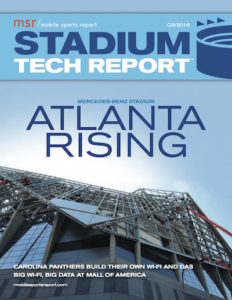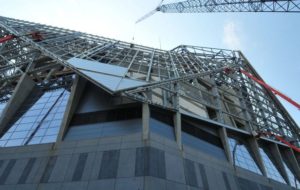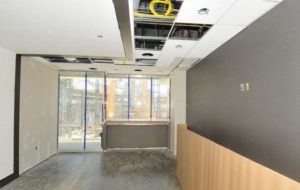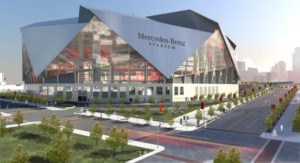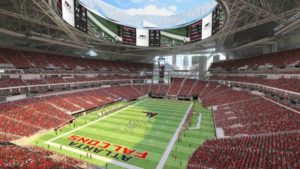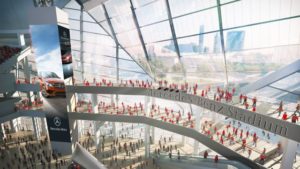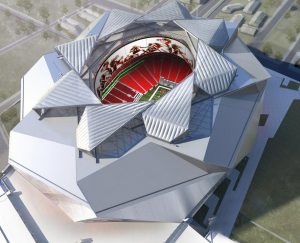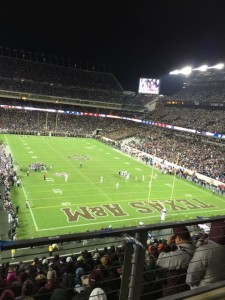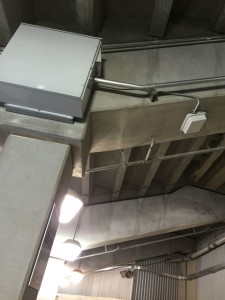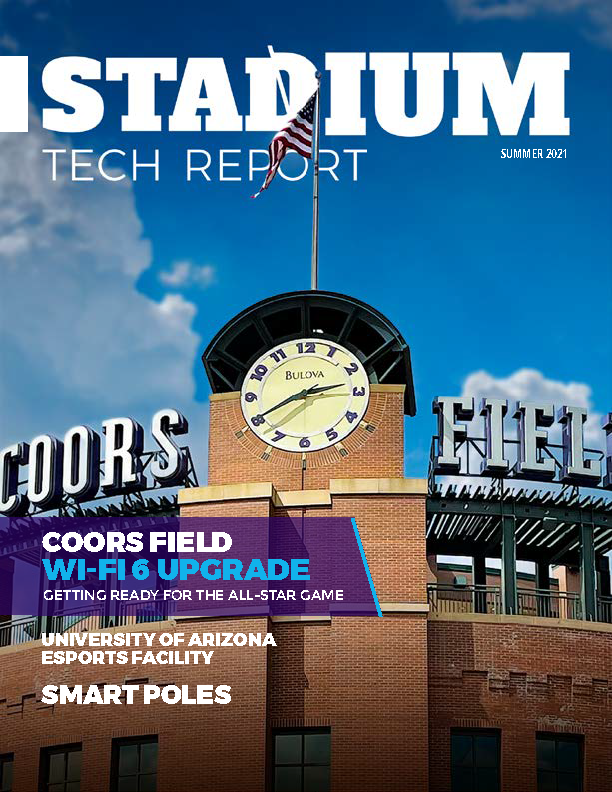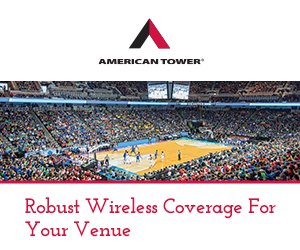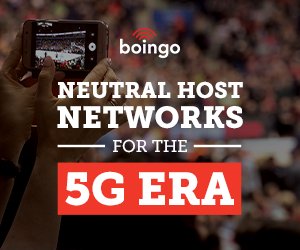We’re still trying to reach out to Rushton for more info, but it’s unclear yet as to what effect his departure will have on IBM’s stadium networking business, which directed projects at Texas A&M as well as at the Atlanta Falcon’s new Mercedes-Benz Stadium, due to open later this year. IBM was also tapped to lead technology deployments at the forthcoming Los Angeles Football Club soccer facility.
LA Chargers name IBM’s Jim Rushton as chief revenue officer
Analysis: The year of the big stadium Wi-Fi upgrade
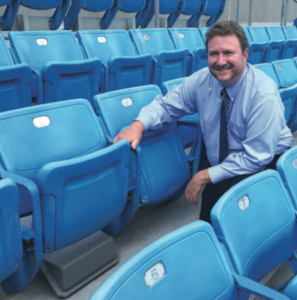
Carolina Panthers director of IT James Hammond shows off a new under-seat Wi-Fi AP at Bank of America Stadium. Credit: Carolina Panthers
Our profile in our latest STADIUM TECH REPORT of Bank of America Stadium in Charlotte, N.C., is a case in point: Thanks to the never-ending demand for more connectivity for fans, stadiums that deployed networks just a few years ago are now finding that those old systems already need upgrades or replacements, typically at a much higher cost than the original network. In addition to BofA Stadium, the New England Patriots’ home, Gillette Stadium, also got a Wi-Fi makeover this past summer, going from about 400 Wi-Fi APs to well over a thousand, with most of the new ones deployed under seats.
According to Fred Kirsch, who oversees the Gillette Stadium network, some of the under-seat placements there were especially tricky, since granite underneath the stands didn’t allow for the ability to drill through the concrete. A workaround involving an above-ground enclosure was envisioned and manufactured, underlining the custom complexity of network deployment found from stadium to stadium. No two are the same, and what works at one may or may not work at another.
But what is common across all these large venues is the ever-increasing need for bandwidth, a moving target that has yet to slow down or stabilize. Last year the story that turned everyone’s head was the need by carriers to upgrade their DAS infrastructure at Levi’s Stadium ahead of Super Bowl 50 – this coming just a year after the stadium had opened for business. While the demands of a Super Bowl (especially Super Bowl 50, which set records for DAS and Wi-Fi usage) are perhaps much different than everyday events, it’s still a safe bet that for many stadiums with Wi-Fi networks – especially the early movers – 2016 has become a year of reckoning, or biting the bullet and writing more checks for more coverage, perhaps seemingly too soon after the initial rollout.
Getting ready for Super Bowl LI
In Houston, NRG Stadium finally has Wi-Fi, and not a moment too soon, with Super Bowl LI on the near horizon. Since the venue didn’t have Wi-Fi prior to this season it’s not really an upgrade but it’s hard to understate the challenge of putting in a Super Bowl-ready network in just one summer, a construction calendar shortened by the fact that integrator 5 Bars and equipment vendor Extreme Networks had to wait until after the NCAA Men’s Final Four was over to begin installing cabling and APs. At of the start of the NFL season the Wi-Fi network is already live at NRG Stadium, and is sure to go through weekly tweaks as the league marches on toward its championship game.
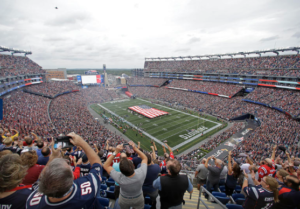
Gillette Stadium before the Sept. 11 game vs. the Miami Dolphins. Credit: Steve Milne, AP, via Patriots.com
New phones and new apps mean more bandwidth demands, leading even those who already have stadium networks to keep wondering if what they’ve installed is enough. We suspect this may be an ongoing story line for the foreseeable future, so – stay tuned here to Mobile Sports Report for the latest success stories and lessons learned from those who have already jumped in or jumped back in to the deployment fray.
Editor’s note: This column is from our latest STADIUM TECH REPORT, which is available for free download from our site. Read about Wi-Fi deployments at Bank of America Stadium, Mercedes-Benz Stadium and more!
IBM formally launches sports consulting practice to bring tech to stadiums

Texas A&M student at recent Aggies football game. Photo: Paul Kapustka, MSR (click on any photo for a larger image)
For industry watchers, the Nov. 19 debut of the IBM “Sports, Entertainment and Fan Experience” consulting practice was not a surprise, since its leader, Jim Rushton, had already appeared at tech conferences this past summer, talking about IBM’s plans to deploy a fiber-based Wi-Fi and DAS network at the new Mercedes-Benz Stadium being built for the Atlanta Falcons. IBM was also publicly behind a similar network build over the last two years at Texas A&M’s Kyle Field. For both networks, IBM is using Corning optical gear.
Still, the formal creation of the IBM practice (you can read all about it at the new IBM sports website) means that the 800-pound gorilla is now firmly inside the competitive ring of the stadium-tech marketplace, a landscape that currently has multiple players, many of which have multiple stadium deployments under their belts. However, IBM’s vast experience in big-time sports technology deployments — Big Blue is behind such endeavors as the truly wonderful online experience of The Masters, as well as technical underpinnings of three of tennis’ Grand Slam events (Wimbledon, the U.S. Open and the Australian Open) — as well as its considerable tech and monetary resources probably makes it a No. 1 contender for all of the biggest projects as well as possibly smaller ones as well.
Rushton, who spoke with Mobile Sports Report earlier this year in one of his first public appearances as an IBMer, said in a phone interview this week that IBM’s fiber-to-the-fan network model isn’t just for large-scale deployments like the one at 105,000-seat Kyle Field or the Falcons’ new $1.4 billion nest, which will seat 71,000 for football and up to 83,000 for other events after it opens in 2017.“That type of system [the optical network] is scalable,” Rushton said, and even in smaller venues he said it could potentially save customers 30 percent or more compared to the cost of a traditional copper-based cabled network. The flip side to that equation is that purchasers have fewer gear suppliers to choose from on the fiber-based side of things, and according to several industry sources it’s still sometimes a problem to find enough technical staffers with optical-equipment expertise.
How much of the market is left?
The other question facing IBM’s new consulting practice is the size of the market left for stadium tech deployments, an answer we try to parse each year in our State of the Stadium survey. While this year’s survey and our subsequent quarterly reports found a high number of U.S. professional stadiums with Wi-Fi and DAS networks already deployed, there are still large numbers of college venues as well as international stadiums and other large public venues like concert halls, race tracks and other areas that are still without basic connectivity.
With its new “global consortium” of companies that supply different parts and services of the connected-stadium experience, IBM could be an attractive choice to a customer that doesn’t have its own technical expertise, providing a soup-to-nuts package that could conceivably handle tasks like in-stadium IPTV, DAS and Wi-Fi, construction and stadium design, and backbone bandwidth solutions.However, IBM will be going up against vendors who have led deployments on their own, and league-led “consortium” type arrangements like MLBAM’s project that brought Wi-Fi to almost all the Major League Baseball stadiums, and the NFL’s list of preferred suppliers like Extreme Networks for Wi-Fi and YinzCam for apps. Also in the mix are third-party integrators like CDW, Mobilitie, 5 Bars, Boingo Wireless and others who are already active in the stadium-technology deployment space. And don’t forget HP, which bought Wi-Fi gear supplier Aruba Networks earlier this year.
Certainly, we expect to hear more from IBM soon, and perhaps right now it’s best to close by repeating what we heard from Jared Miller, chief technology officer for Falcons owner Arthur Blank’s namesake AMB Sports and Entertainment (AMBSE) group, when we asked earlier this year why the Falcons picked IBM to build the technology in the new Atlanta stadium:
“IBM is unique with its span of technology footprint,” Miller said. He also cited IBM’s ability to not just deploy technology but to also help determine what the technology could be used for, with analytics and application design.
“They’ve looked at the [stadium] opportunity in a different manner, thinking about what we could do with the network once it’s built,” Miller said.
From the IBM press release, here is the IBM list of companies in its new “global consortium,” which IBM said is not binding, meaning that none of the companies listed is guaranteed any business yet, and others not on the list may end up in IBM deployments, like Kyle Field, which uses Aruba gear for the Wi-Fi:
Founding members of the consortium, include:
· Construction and Design: AECOM, HOK, Whiting Turner
· Infrastructure Technology/Carriers: Alcatel/Lucent, Anixter, Commscope, Corning, Juniper Networks, Ruckus Wireless, Schneider Electric, Smarter Risk, Tellabs, Ucopia, Zebra Technologies, YinzCam (IPTV), Zayo, Zhone
· Communications Solutions Providers: Level 3, Verizon Enterprise Solutions, AT&T
· Fan Experience Consulting & Data Management Integration: IBM

